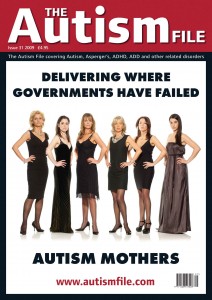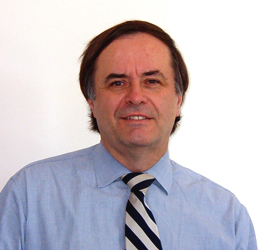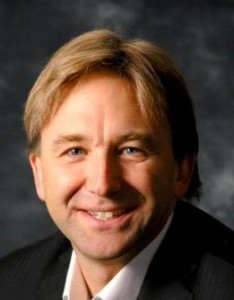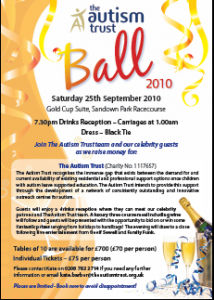
- This event has passed.
Autism Conference
September 25, 2010 - September 26, 2010
 The Autism File, an International Magazine dedicated to bringing the latest ideas and strategies about autism to parents, clinicians and carers is holding its annual conference
The Autism File, an International Magazine dedicated to bringing the latest ideas and strategies about autism to parents, clinicians and carers is holding its annual conference
On: Saturday 25th & Sunday 26th September 2010
At: Tingle Creek Conference Suite, Sandown Park Racecourse, Esher, Surrey KT10 9AJ
To download a booking form please click here: Autism Conference Booking Form
Day 1 – Saturday 25th September 2010
| 08.00 – 09.00 | Delegate Registration and Exhibitor viewing |
| 09.00 – 09.15 | Welcome |
| 09.15 – 10.00 | Jonathan Tommey: The Biomedical Imbalances in Autism Spectrum Conditions |
| 10.00 – 11.00 | Lori Knowles: A Mother’s Success Story: Daniel’s Journey Out of Autism |
| 11.00 – 11.30 | Break and Exhibitor viewing |
| 11.30 – 13.00 | Dr William Shaw: Promising New Insights, Therapies, and Tests for Autism and PDD – Part I |
| 13.00 – 14.00 | Lunch and Exhibitor viewing |
| 14.00 – 15.00 | Michael Ash: Mucosal Immunity and Autism – Is There a Link? And What Do I Do About It? |
| 15.00 – 16.00 | Dr William Shaw: Promising New Insights, Therapies, and Tests for Autism and PDD – Part II |
| 16.00 – 16.30 | Break |
| 16.30 – 17.15 | Mr Paul Shattock OBE: How Do I Know What Will Work? |
| 17.15 – 17.45 | Mrs Polly Tommey: The Future: Where Will Our Children Be When We Are No Longer Around? |
| 17.45 – 18.00 | Q&A – Speakers |
The Biomedical Imbalances in Autism Spectrum Conditions
This presentation will give an insight, in brief, into the many underlying physical, behavioural and emotional issues associated with Autism Spectrum Conditions (ASCs). These will, over the course of the weekend, be explained in greater detail to enable a greater awareness of such imbalances with the focus on identification and treatment. The identification of health symptoms will determine where investigations should take you, and with the guidance of a qualified and experienced expert, you can begin to understand the layers of illness that affect your child and begin to put in place measures to address them.
Learning Objectives.
- To be aware of the many “hidden” imbalances in ASCs.
- To have the knowledge to help support your child through closer symptom assessment and specificity of treatment.
A Mother’s Success Story: Daniel’s Journey Out of Autism
 Unsure if you should consider biomedical approaches in treating autism? Are you confused about where and how to get started? Lori’s presentation is designed for those new to the biomedical approach and for those seeking an easy to understand overview of some of the foundational biomedical treatments. She will include an overview of the therapies that contributed to her son’s recovery; including dietary intervention, applied behavioural analysis (ABA), yeast and bacteria treatments, supplements therapy, detoxification and other alternative treatments that helped play a part. This is a practical and parent-friendly presentation that will inspire and give you hope. Share in Daniel’s progress through his mother’s account, pictures and video segments.
Unsure if you should consider biomedical approaches in treating autism? Are you confused about where and how to get started? Lori’s presentation is designed for those new to the biomedical approach and for those seeking an easy to understand overview of some of the foundational biomedical treatments. She will include an overview of the therapies that contributed to her son’s recovery; including dietary intervention, applied behavioural analysis (ABA), yeast and bacteria treatments, supplements therapy, detoxification and other alternative treatments that helped play a part. This is a practical and parent-friendly presentation that will inspire and give you hope. Share in Daniel’s progress through his mother’s account, pictures and video segments.
Learning Objectives
Participants will:
- Gain a basic overview and understanding of each foundational biomedical therapy that is useful in treating autism. The therapies discussed include diet, yeast and bacteria treatment, nutritional supplements and detoxification.
- Identify the specific symptoms in children who may benefit from biomedical interventions and how these symptoms can be alleviated through each intervention.
- Gain a good understanding of how all of the biomedical therapies work together – along with educational therapies – to offer hope for significant improvement and sometimes recovery.
- Obtain practical information on how to get started pursuing biomedical treatments for autism.
Promising New Insights, Therapies, and Tests for Autism and PDD – Part I
 Many new technologies have revealed significant new factors as causes of autistic spectrum disorders including genomics, proteomics, and metabolomics, disciplines involved in mass screening of genes, proteins and metabolic processes in humans. These technologies have already led to significant new therapeutic trials for autistic spectrum disorders. In addition, a number of recent studies have implicated both environmental factors and genetic factors related to detoxification as critical in autistic spectrum disorders. One of the most promising discoveries has been the finding that the majority of individuals on the autistic spectrum are deficient in cholesterol and have abnormal amounts of cholesterol transport proteins. A recent article indicates that cholesterol supplementation should be considered in all cases of autistic spectrum disorder. Treatment of severe deficiency has led to reductions of infections, improvements in sleep, social interactions, and growth. Behavioural improvements include reduction in self-hurtful behaviour, temper tantrums, aggressive behaviour and hyperactivity. Cholesterol is a critical factor in myelin production needed for brain growth and development, a co-factor in the brain development protein sonic hedgehog, a precursor of all steroid hormones and bile salts, and a critical factor in the function of serotonin and oxytocin receptors. Oxytocin, a hormone that stimulates social interaction and trust, has been found to be low in the blood of children with autism. Supplementation of oxytocin reduces autistic behaviours; combining cholesterol and oxytocin may be an especially effective treatment.
Many new technologies have revealed significant new factors as causes of autistic spectrum disorders including genomics, proteomics, and metabolomics, disciplines involved in mass screening of genes, proteins and metabolic processes in humans. These technologies have already led to significant new therapeutic trials for autistic spectrum disorders. In addition, a number of recent studies have implicated both environmental factors and genetic factors related to detoxification as critical in autistic spectrum disorders. One of the most promising discoveries has been the finding that the majority of individuals on the autistic spectrum are deficient in cholesterol and have abnormal amounts of cholesterol transport proteins. A recent article indicates that cholesterol supplementation should be considered in all cases of autistic spectrum disorder. Treatment of severe deficiency has led to reductions of infections, improvements in sleep, social interactions, and growth. Behavioural improvements include reduction in self-hurtful behaviour, temper tantrums, aggressive behaviour and hyperactivity. Cholesterol is a critical factor in myelin production needed for brain growth and development, a co-factor in the brain development protein sonic hedgehog, a precursor of all steroid hormones and bile salts, and a critical factor in the function of serotonin and oxytocin receptors. Oxytocin, a hormone that stimulates social interaction and trust, has been found to be low in the blood of children with autism. Supplementation of oxytocin reduces autistic behaviours; combining cholesterol and oxytocin may be an especially effective treatment.
Learning Objectives:
- Learn why cholesterol is an essential nutrient necessary for growth, development, and normal behaviour.
- Understand the evidence for abnormal cholesterol production and/or transport in different types of autism and treatments that are currently available.
Mucosal Immunity and Autism – Is There a Link? And What Do I Do About It?
 Michael Ash BSc DO ND Dip ION has a special interest in the role of the ‘wet surfaces’ of the body in relation to immune function. For over 20 years he has been researching the consequences of loss of mucosal tolerance and its effects on human health both locally and systemically. For the last 12 years he has been exploring the use of natural and pharmaceutical agents in the management of the gastrointestinal tract and its effects on well being and behaviour in individuals diagnosed on the AS. His presentation will link the mechanisms of immune disruption and potential interventions based on extensive clinical experience and research reviews.
Michael Ash BSc DO ND Dip ION has a special interest in the role of the ‘wet surfaces’ of the body in relation to immune function. For over 20 years he has been researching the consequences of loss of mucosal tolerance and its effects on human health both locally and systemically. For the last 12 years he has been exploring the use of natural and pharmaceutical agents in the management of the gastrointestinal tract and its effects on well being and behaviour in individuals diagnosed on the AS. His presentation will link the mechanisms of immune disruption and potential interventions based on extensive clinical experience and research reviews.
Whilst the immune system is very complicated, simple safe interventions have the capacity to induce positive immune changes restoring tolerance and creating a significant change in function and behaviour. After this lecture parents and clinicians will be able to assess the current evidence for immune disruption and mucosal surface involvement and be able to understand the role of probiotics and other agents in the restoration of mucosal integrity.
Promising New Insights, Therapies, and Tests for Autism and PDD – Part II
 A number of genetic abnormalities have been found in individuals with autistic spectrum disorders at greater incidence rates than in normal people. Many of these genetic factors are called single nucleotide polymorphisms or SNPs (pronounced SNIPS) of the deoxyribonucleic acid (DNA) in the genes that regulate folate, B-12, methylation reactions, and sulfur amino acid metabolism in a complex interrelated metabolic pathway. Furthermore, the presence of certain SNPs makes the individual more susceptible to vitamin deficiencies and exposure to toxic chemicals. Household products such as cleaners, paints and solvents, lawn and garden care, automotive products, pool chemicals, and health and beauty aids, are usually the main source of exposure since they are prevalent in the environment. We suggest patients can reduce their exposure by making small changes in their lifestyle and purchasing habits, such as not using pesticides and avoiding cosmetics and toiletries with synthetic fragrances. Several studies have now confirmed that many of these products may be involved in causing autistic spectrum disorders (ASD), and some of the genetic factors that increase vulnerability of ASD people to toxic chemicals have been identified. The use of this new information in helping the treatment of ASD will be emphasized.
A number of genetic abnormalities have been found in individuals with autistic spectrum disorders at greater incidence rates than in normal people. Many of these genetic factors are called single nucleotide polymorphisms or SNPs (pronounced SNIPS) of the deoxyribonucleic acid (DNA) in the genes that regulate folate, B-12, methylation reactions, and sulfur amino acid metabolism in a complex interrelated metabolic pathway. Furthermore, the presence of certain SNPs makes the individual more susceptible to vitamin deficiencies and exposure to toxic chemicals. Household products such as cleaners, paints and solvents, lawn and garden care, automotive products, pool chemicals, and health and beauty aids, are usually the main source of exposure since they are prevalent in the environment. We suggest patients can reduce their exposure by making small changes in their lifestyle and purchasing habits, such as not using pesticides and avoiding cosmetics and toiletries with synthetic fragrances. Several studies have now confirmed that many of these products may be involved in causing autistic spectrum disorders (ASD), and some of the genetic factors that increase vulnerability of ASD people to toxic chemicals have been identified. The use of this new information in helping the treatment of ASD will be emphasized.
Learning Objectives:
- Learn about common genetic variations called SNPs present in autism and how these variations make the individual more susceptible to exposure to toxic chemicals and nutritional deficiencies.
- Understand the role of a wide range of toxic chemicals in inducing autism and how to reduce exposures and how to detoxify the chemicals that are in the body.
How Do I Know What Will Work?
 Presentation will include considerations on where parents can obtain unbiased opinions; the science upon which some of these opinions are based; the importance of testing and of careful observations of what happens when intervention is being tested; how different interventions can interact and where researchers are looking for further insights.
Presentation will include considerations on where parents can obtain unbiased opinions; the science upon which some of these opinions are based; the importance of testing and of careful observations of what happens when intervention is being tested; how different interventions can interact and where researchers are looking for further insights.
The Future: Where Will Our Children Be When We Are No Longer Around?
 Polly Tommey is the mother of a child with autism. She will be discussing the issue of ‘Where will our children be when we are no longer around?’, how The Autism Trust will attempt to address this, and how we can work together to achieve this goal. The Autism Trust is the UK charity of which she is the Founder, established in 2007. It is focused on and dedicated to building an inspiring and sustainable future for children with autism in the UK when they leave full time education. Polly will be discussing the need for The Trust in this country, creating a wonderful introduction to the charity before the Autism Trust Ball that evening.
Polly Tommey is the mother of a child with autism. She will be discussing the issue of ‘Where will our children be when we are no longer around?’, how The Autism Trust will attempt to address this, and how we can work together to achieve this goal. The Autism Trust is the UK charity of which she is the Founder, established in 2007. It is focused on and dedicated to building an inspiring and sustainable future for children with autism in the UK when they leave full time education. Polly will be discussing the need for The Trust in this country, creating a wonderful introduction to the charity before the Autism Trust Ball that evening.
 Autism Trust Ball 2010, which will take place on the Saturday evening, at 7.30 pm at the same venue. This charity event is held to raise awareness and to generate funds to enable a brighter future for individuals with an ASC. The evening will offer a 3-course dinner, fantastic live entertainment, celebrity guests, and a superb auction and will provide a fantastic opportunity for us all to come together and have a night out.
Autism Trust Ball 2010, which will take place on the Saturday evening, at 7.30 pm at the same venue. This charity event is held to raise awareness and to generate funds to enable a brighter future for individuals with an ASC. The evening will offer a 3-course dinner, fantastic live entertainment, celebrity guests, and a superb auction and will provide a fantastic opportunity for us all to come together and have a night out.
Day 2 – Sunday 26th September 2010
| 08.00 – 09.00 | Delegate Registration and Exhibitor viewing |
| 09.00 – 09.15 | Welcome |
| 09.15 – 10.00 | Jonathan Tommey: The Assessment and Treatment of Autism Spectrum Conditions In Clinical Practice |
| 10.00 – 11.00 | Christine Bailey: Dietary Intervention – The Parent Friendly Guide To What Works and How To Do It |
| 11.00 – 11.30 | Break and Exhibitor viewing |
| 11.30 – 13.00 | Dr William Shaw: Multifactorial Causes of Autism and Developmental Disorders |
| 13.00 – 14.00 | Lunch and Exhibitor viewing |
| 14.00 – 15.30 | Dr William Shaw: Impaired Detoxification, Metabolism, and Oxidative Stress in ASD |
| 15.30 – 16.00 | Break and Exhibitor viewing |
| 16.00 – 17.00 | Dr William Shaw: KEYNOTE PRESENTATION: The Toxic Chemicals Test Profile: An Inexpensive and Comprehensive Urine Test for a Number of Environmental Chemicals in Autism and Developmental Disorders |
| 17.00 – 17.30 | Q&A – Speakers |
The Assessment and Treatment of Autism Spectrum Conditions In Clinical Practice
The Autism Clinic currently treats over 600 individuals with an autism spectrum condition. Autism must be addressed and treated, not only as a psychological condition but more accurately, as a biomedical disorder, initiating aberrant psychological responses. Issues from gastro-intestinal disturbances such as diarrhoea, constipation and dysbiosis, to immunological and metabolic imbalances, to detoxification and neurological problems exist in the majority.
The aim of the Autism Clinic is to address all issues that are relevant to each unique sufferer emphasising specificity and detail. Information gathering from parents, questionnaires, the use of diagnostic testing and observation is imperative. The more one unveils and understands, the more accurate and appropriate the protocol. Some of the pathologies associated with autism spectrum conditions and specific use of nutritional support will be discussed, addressing such issues as sleep disturbances, intestinal permeability, hyperactivity, eczema and so on.
Learning Objectives:
- How to gain insight and knowledge. A detailed use of an extensive questionnaire
- Identifying which tests may be relevant to the patient
- Information gathering and using research to support your approach
- Identify symptoms, such as behavioural and physical, and understand how these can be initiated by chemical imbalances and nutrient deficiencies
- How you can improve your treatment of individuals with ASCs
Dietary Intervention – The Parent Friendly Guide To What Works and How To Do It
When it comes to the autistic spectrum, diet really does matter. Children with these disorders not only suffer from maldigestion and functional nutritional deficiencies but some of what is absorbed into the bloodstream can act as false neurotransmitters and allergens. One of the most difficult activities parents face is implementing a diet that their children may resist. In addition, the number of dietary protocols available and recommendations only add to the confusion. Christine Bailey a qualified nutritionist and chef will guide you through the range of options including distinguishing between food allergies, sensitivities and intolerances; opiate effects and identifying the common culprits. Gluten, casein, soy and corn free diets will be discussed, plus specific carbohydrate diets – disaccharides deficiency, yeast, The Feingold Diet – salicylates intolerance, phenol intolerance – phenol sulfotransferase PST deficiency and more. Christine advises many families and parents on dietary intervention, how to create suitable recipes, and gives advice on preparing healthy nutritious food for children with often limited appetites, food aversions and sensory problems. Here she shares some tips and advice to guide parents through the dietary maze.
Multifactorial Causes of Autism and Developmental Disorders
 The talk covers Dr William Shaw’s perspective on the metabolic causes of autism and developmental disorders. Genetic variations of the immune system, inborn errors of metabolism, or adverse reactions to immunisations lead to recurrent infections that are commonly treated with antibiotics. A yeast overgrowth of the gastrointestinal (GI) tract occurs following the elimination of the GI normal flora with antibiotic treatments. Yeast produce abnormal compounds called gliotoxins and other immunotoxins harmful to the immune system. Because the immune system is weakened, the child gets another infection and more antibiotics until a vicious cycle is established. The yeast produces a number of harmful effects on the child’s metabolic and neurological functioning, including impairing gastrointestinal functioning, production of excess oxalates, inhibiting energy production and eliciting food allergies that may manifest as behaviour disorders. Discussion will include why high oxalate foods may contribute to negative effects including formation of crystals in tissues.
The talk covers Dr William Shaw’s perspective on the metabolic causes of autism and developmental disorders. Genetic variations of the immune system, inborn errors of metabolism, or adverse reactions to immunisations lead to recurrent infections that are commonly treated with antibiotics. A yeast overgrowth of the gastrointestinal (GI) tract occurs following the elimination of the GI normal flora with antibiotic treatments. Yeast produce abnormal compounds called gliotoxins and other immunotoxins harmful to the immune system. Because the immune system is weakened, the child gets another infection and more antibiotics until a vicious cycle is established. The yeast produces a number of harmful effects on the child’s metabolic and neurological functioning, including impairing gastrointestinal functioning, production of excess oxalates, inhibiting energy production and eliciting food allergies that may manifest as behaviour disorders. Discussion will include why high oxalate foods may contribute to negative effects including formation of crystals in tissues.
Learn about the most common metabolic causes of autism and developmental disorders: intestinal dysbiosis, cholesterol deficiency, food allergies, industrial pollution, heavy metals intoxication, mineral imbalances and high levels of oxalates. There will be a discussion on how IgG food allergies affect behaviour and how to detect the most common allergens. Find out how the mechanism of opiate peptides affects the brain, their connection with allergies, and the importance of a gluten and casein-free diet. During the presentation there will be a focus on the damaging effects of heavy metals, such as mercury, lead, cadmium, arsenic, aluminium and others, as well as the mechanism of their effect on human development and ways to detect and treat high levels of these metals. You will also be able to learn about the correlation between low cholesterol and brain function. Dr Shaw will introduce the concept of cholesterol supplementation for certain patients and review many other effective ways of correcting or reducing abnormalities with biomedical interventions.
Learning Objectives:
- Find out about the newest biomedical research developments
- Treat ‘inborn errors of metabolism’
- Learn about leaky gut syndrome
- Treat food allergies using special dietary interventions including eliminating wheat and dairy
- Find out why heavy metals play a role in autism and developmental disorders
- Learn why the level of cholesterol is important for brain function
Impaired Detoxification, Metabolism, and Oxidative Stress in ASD
 Autism is a severe developmental disorder with poorly understood etiology. Oxidative stress in autism has been studied at the membrane level and by measuring products of lipid peroxidation, detoxifying agents (such as glutathione) and antioxidants. Learn about the potential mechanisms that may mediate neuronal dysfunction and clinical symptoms in autism. The brain is very susceptible to oxidative stress due to its susceptibility to free radicals. Sources of free radicals production can come from the high use of oxygen and glucose. High levels of iron in the brain also cause significant production of free radicals that cause significant peroxidation of the fats in the cell membrane. Once the brain has been damaged it has a very limited capacity to regenerate.
Autism is a severe developmental disorder with poorly understood etiology. Oxidative stress in autism has been studied at the membrane level and by measuring products of lipid peroxidation, detoxifying agents (such as glutathione) and antioxidants. Learn about the potential mechanisms that may mediate neuronal dysfunction and clinical symptoms in autism. The brain is very susceptible to oxidative stress due to its susceptibility to free radicals. Sources of free radicals production can come from the high use of oxygen and glucose. High levels of iron in the brain also cause significant production of free radicals that cause significant peroxidation of the fats in the cell membrane. Once the brain has been damaged it has a very limited capacity to regenerate.
The Toxic Chemicals Test Profile: An Inexpensive and Comprehensive Urine Test for a Number of Environmental Chemicals in Autism and Developmental Disorders
 One of the greatest difficulties in environmental medicine is deciding what testing needs to be done on each patient. Patients have almost always been exposed to a wide array of toxic chemicals. Patient history may not be able to reveal the number of chemicals to which patients have been exposed since many chemicals are present in food, water, air and common household products to which the majority of patients are exposed. Comprehensive testing of multiple chemical screening tests may be so expensive that such testing becomes out of the reach of the financial ability of many patients. To meet this need, a single urine screening test, called OrganoGold has been developed for some of the most common chemicals in the environment including phthalates, organophosphate pesticides, herbicides, contaminants in drinking water, dry cleaning solvents, chemical degreasers, solvents like benzene, xylene, vinyl chloride, pyrethrin insecticides, cosmetic additives, polystyrene and toxic gasoline additives. A new technology has been developed to screen for the presence of 75 different toxic chemicals in a single urine test and is useful for measuring the therapeutic efficacy of different therapies for detoxification as well as measuring the improvement in mitochondrial function during detoxification. Application of this testing has revealed that toxic exposure from a wide range of chemicals is commonly associated with metabolic indicators of mitochondrial damage, resulting in severe loss of energy production and premature senescence and cell death. These metabolic indicators of mitochondrial damage are also tested in the same simple urine test. Many toxic chemicals cause the increased production of reactive oxygen species (ROS), which cause mitochondrial DNA (mt DNA) damage. Mitochondrial damage or dysfunction is associated with a wide array of diseases including schizophrenia, bipolar disease, dementia, Alzheimer’s disease, epilepsy, migraine headaches, strokes, neuropathic pain, Parkinson’s disease, ataxia, transient ischemic attack, cardiomyopathy, coronary artery disease, chronic fatigue syndrome, fibromyalgia, retinitis pigmentosa, diabetes, hepatitis C and primary biliary cirrhosis. The new toxic chemical screen is useful for measuring the therapeutic efficacy of different therapies for detoxification as well as measuring the improvement in mitochondrial function during detoxification.
One of the greatest difficulties in environmental medicine is deciding what testing needs to be done on each patient. Patients have almost always been exposed to a wide array of toxic chemicals. Patient history may not be able to reveal the number of chemicals to which patients have been exposed since many chemicals are present in food, water, air and common household products to which the majority of patients are exposed. Comprehensive testing of multiple chemical screening tests may be so expensive that such testing becomes out of the reach of the financial ability of many patients. To meet this need, a single urine screening test, called OrganoGold has been developed for some of the most common chemicals in the environment including phthalates, organophosphate pesticides, herbicides, contaminants in drinking water, dry cleaning solvents, chemical degreasers, solvents like benzene, xylene, vinyl chloride, pyrethrin insecticides, cosmetic additives, polystyrene and toxic gasoline additives. A new technology has been developed to screen for the presence of 75 different toxic chemicals in a single urine test and is useful for measuring the therapeutic efficacy of different therapies for detoxification as well as measuring the improvement in mitochondrial function during detoxification. Application of this testing has revealed that toxic exposure from a wide range of chemicals is commonly associated with metabolic indicators of mitochondrial damage, resulting in severe loss of energy production and premature senescence and cell death. These metabolic indicators of mitochondrial damage are also tested in the same simple urine test. Many toxic chemicals cause the increased production of reactive oxygen species (ROS), which cause mitochondrial DNA (mt DNA) damage. Mitochondrial damage or dysfunction is associated with a wide array of diseases including schizophrenia, bipolar disease, dementia, Alzheimer’s disease, epilepsy, migraine headaches, strokes, neuropathic pain, Parkinson’s disease, ataxia, transient ischemic attack, cardiomyopathy, coronary artery disease, chronic fatigue syndrome, fibromyalgia, retinitis pigmentosa, diabetes, hepatitis C and primary biliary cirrhosis. The new toxic chemical screen is useful for measuring the therapeutic efficacy of different therapies for detoxification as well as measuring the improvement in mitochondrial function during detoxification.
Learning Objectives:
- Prevent health impairment, assist in risk assessment, and help evaluate the effectiveness of environmental controls.
- Describe practical aspects in controlling toxic environmental exposures.
- Describe manifestations of chemical toxicity and sensitivities from various chemicals, such as: pesticides, solvents, and heavy metals in major biological systems, including neurotoxicity and immunotoxicity.
- Discuss available methods for detecting chemical contamination of the environment.
- Enhance comprehension of multiple impacts of toxic environmental exposures to the patient’s health.
- Provide practical solutions for patients, in order to control the amount of exposure to common environmental and chemical pollutants, and how to detoxify when exposed.
